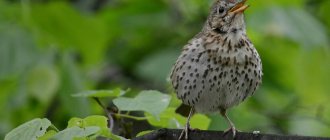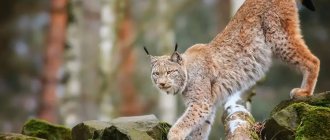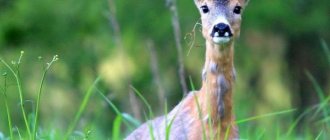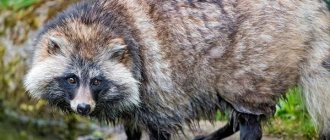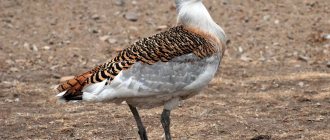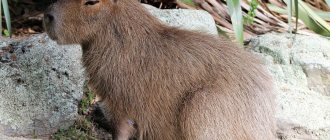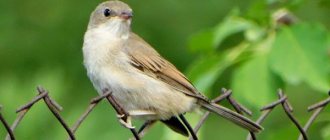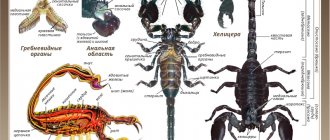- How long does a lynx live?
It just so happens that some of the most formidable predators on our planet are representatives of the cat family, and every kind and affectionate cat has very formidable relatives. One of them is the lynx, which, in fact, is large, wild and, of course, very predatory
a cat that lives in the forests. Our article today is about her.
Description, structure, characteristics
The average body length of a lynx is from 80 to 130 cm. The weight of a lynx, if it is a male, is from 18 to 25 kg, females are slightly smaller and correspondingly lighter, their weight is usually 17-18 kg. The body of this animal is short and dense.
It has, like all cats, a tail, although it is a lynx tail, usually with a chopped off end. The lynx's ears are decorated with fluffy tassels. Also, these “cats” have elongating hair on the beard, creating a kind of sideburn. The lynx's muzzle is round and small, but its eyes are larger, and with vertical pupils. Her vision is very good, besides, the lynx is able to see in the dark, the same can be said about hearing and smell, all these senses in lynxes are as well developed as in ordinary cats.
The lynx's fur is thick, silky and beautiful. Large and fluffy paws provide an excellent opportunity for the animal to move through the snow in winter. The color of the lynx varies depending on its species and habitat, from red to gray-brown.
Why does the lynx have a short tail?
All representatives of felines use the tail for maneuvering and quickly changing the direction of running while pursuing prey. The lynx spends most of its time in the trees and prefers to hunt from ambush, so the tail does not play such an important role for it. On the contrary, a long tail would prevent the animal from quickly moving along branches and hiding in hollows. This is most likely why the lynx is the cat with the shortest tail.
SNOW LEOPARD
Habitats
The lynx lives over a very wide geographical range, but exclusively in the northern hemisphere of our planet: in North America (in the USA and Canada), in the north of Eurasia: these cats can be found in the Siberian taiga, and in the mountains of China and Tibet, and in the Scandinavian peninsula. As for our country Ukraine, the common lynx is found, among other things, in the Carpathian forests.
The lynx always chooses dense forest areas as its habitat. It happens that in search of prey, lynxes can go to forest edges or meadows, but they do not stay there for long, always returning to their native forest thickets.
Features of color
The coat of these animals depends on their habitat and is represented by many options, including different colors. Therefore, there are species with a reddish-brown color, as well as types of pale-smoky tones, as well as their variants. In this case, a pattern may appear on the body in the form of spots on the back and paws, including on the sides of the predator.
The lynx's belly is covered with long and fairly soft hair, but not thick, distinguished by a white tint, with barely noticeable specks. Lynxes living in the southern regions are characterized by a red coloration, while they have relatively short and dense hair. Lynxes shed twice a year, both in spring and autumn.
Nutrition
It will probably be unnecessary to say that the lynx is an incorrigible predator (like all cats), so its diet consists of various forest animals, most often hares. The lynx also hunts various small rodents, roe deer,
deer (but young ones; an adult deer, which also has powerful antlers, is not always easy to cope with), black grouse birds. Sometimes partridges, raccoons, hazel grouse and even foxes become its prey.
What does it eat?
The diet largely depends on the variety. Small lynxes eat rodents, birds, and hares. Larger common lynxes attack wild boars, young moose, roe deer and deer.
Every day the animal needs to eat up to 2 kg of meat. The lynx covers the uneaten remains of carcasses with fallen leaves or snow. Very often, poorly hidden prey is found by other predators.
MANUL
Enemies in nature
As for the lynx itself, besides humans, its main enemy in natural conditions is
wolf. Or rather, wolves, who, when gathered in a pack, can easily tear a wild cat apart. Knowing this, lynxes try to avoid places where there are many wolves. As you can see, here in the battle between the collectivism of representatives of the canine family - wolves, and the individualism of representatives of the cat family - lynxes, collectivism wins, despite the fact that a single lynx is stronger than a single wolf; it cannot resist a well-coordinated wolf pack.
Where does it live?
Photo: Lynx cat
The lynx lives in rugged forests where there is a lot of prey. In sparse forests or bush thickets it is much less common. This cat is also found in mountains and cactus thickets. A lynx will never settle in open areas. In general, she tries to stay as far away as possible in the territories she inhabits.
The common lynx lives only in the Northern Hemisphere of the Earth. Its habitat extends almost throughout Scandinavia, Europe, to the east and north of Russia, and further to Central Asia.
Countries where the common lynx is found:
- Balkan Peninsula: Serbia, Macedonia, Albania;
- Germany;
- Carpathians: from the Czech Republic to Romania;
- Poland;
- Belarus;
- Ukraine;
- Russia;
- Scandinavia: Norway, Finland, Sweden;
- France;
- Switzerland;,
- Transcaucasia: Azerbaijan, Armenia, Georgia;
- Central Asia: China, Mongolia, Kazakhstan, Uzbekistan, Tajikistan, Kyrgyzstan;
- Baltics.
Among the entire family of cats, the common lynx is the most cold-resistant animal. It is found even beyond the Arctic Circle, in Scandinavia. Once upon a time this animal could be seen in any part of Europe. But by the middle of the 20th century it was almost completely exterminated in Central and Western Europe.
Today they are trying to restore the population of these cats, and very successfully. However, it is scarce everywhere. In Russia, 90% of lynxes live in Siberian coniferous forests, although they are found from the western borders of the country to Sakhalin itself.
Lifestyle
As we wrote just above, lynx prefers dense forests as habitats. Taiga is an ideal place for lynx. All lynxes can climb trees well and swim well. The spotted color of the lynx helps to camouflage it. These animals lead a solitary lifestyle, at most in pairs of male + female, in which they lose to their competitors, wolves.
In search of food, a lynx can walk up to 30 km a day. They go out hunting at dusk, lying in wait for potential prey in ambush, then making a sharp jerk - the speed of a lynx during a rapid rush can reach up to 40 km per hour. It is interesting that the lynx is not too afraid of people, and may well attack, including a person, but only if it is very persistent and careless, it usually prefers other loess game.
Dimensions
Adults grow in length from 80 to 130 cm, and the height at the withers reaches about 70 cm. An adult lynx, well-fed and well-formed, is similar in size and weight to a large dog. Vigorous, healthy males reach a weight of 18 to 25 kilograms, although some individuals gain weight in the range of 30 kilograms. Females are slightly smaller in size and weigh no more than 20 kg.
Types, photos and names
There are several types of lynx, below we will describe them in more detail.
Common lynx
The most common representative of this species, everything that we wrote above, is primarily swayed by the common lynx.
Canada lynx
Some zoologists consider it a subspecies of the common lynx. As the name suggests, this lynx lives mainly in Canada, but it can also be found in a number of northern US states (Idaho, Montana). It also differs from the ordinary lynx in being half the size; its body length is 48-56 cm. The fur of the Canadian lynx is grayish-brown in color.
Iberian lynx
This type of lynx is found in the southwest of Spain, nowadays mainly only in the territory of the Coto Doñana National Park and is the rarest in nature. If the lynx as a whole species is included in
Red Book, since it is endangered, the Iberian lynx is currently not only one of the rarest mammals on planet Earth - according to zoologists, its population is currently only about 100 individuals, and Every effort must be made to preserve the Iberian lynx into the future.
In appearance, the Iberian lynx differs from the usual one in that it has a lighter coat color and the presence of pronounced spots, which gives it a resemblance to a leopard.
Red Lynx
Living in the United States, the red lynx is distinguished by its red-brown color, with gray shades, and the presence of a white mark on the inside of the tip of the tail (other lynxes have black). It is also smaller in size compared to the common lynx; the weight of the red lynx is 6-11 kg. And what is most interesting, among red lynxes there are sometimes melanists, that is, representatives with a completely black color, which, like representatives of melanistic jaguars and melanistic leopards, are called
Panthers
Interesting facts about lynx
- In ancient Greek mythology, there is a legend about the Scythian king Linkh, who wanted to deceive himself for the glory of being a teacher of agriculture. Demeter, having learned about this, turned Linkh into a spotted cat, and the dagger thrown by the goddess after the fleeing animal cut off part of its tail. This is how the lynx with its shortened tail appeared in the animal kingdom. The scientific name of the lynx Lynx is taken from the ancient Greek language and is consonant with the name of the Scythian king. Translated, it means “red”.
- For a long time, the caracal (steppe lynx), which lives on the African continent and East Asia, was classified as a genus of lynx. However, genetic analysis showed that this species has a number of differences, and therefore caracals were classified as a separate genus.
- Lynxes have excellent hearing and sharp eyesight. In ancient times, they were credited with supernatural abilities, including the ability to see through objects.
- With the onset of cold weather, the lower part of the lynx's paws becomes covered with fur. Thick fur allows the animal to move through the snow without falling through.
Reproduction
The mating season for lynxes, like their close relatives cats, begins in March. And it is also accompanied by loud purring and meowing (those who have domestic cats know what this is). It happens that several males begin to court one female at once, and she chooses the strongest and most worthy among them. As a sign of love, lynxes often lick each other's fur.
Lynx pregnancy lasts 65-75 days, usually 2-3 lynx cubs are born at a time. Again, like their closest feline relatives, they are born blind, their eyes appear only on the 12th day of life. At first, the mother lynx takes every possible care of the babies and feeds them. In general, with lynxes everything happens here very similar to domestic cats.
Domestic cats
There are several breeds of domestic cats that resemble lynxes or caracals. Some of them are of natural origin, others were bred artificially.
Pixiebob
These animals resemble lynxes due to the tufts on their ears and short tail.
Story
The breed was developed by American felinologist Carol Ann Brewer. In 1985, she bought a tailless cat with polydactyly (increased number of toes), and a year later adopted a short-tailed street cat - very large, despite emaciation, weighing about 8 kg. From the mating of these animals, a girl was born, who, due to her spotted color and short, wide muzzle, resembled a lynx. This is where the breeding program began.
Some pixiebobs look surprisingly like lynxes
Currently, pixiebobs are recognized by the ACFA, CCA, TICA and UFO.
Appearance
The TICA standard assumes the following appearance of pixie bobs:
- The body is massive. Cats weigh 4.5–5 kg, males - from 5 to 9 kg. The chest is wide, the belly hangs slightly.
- The legs are muscular, the hind legs are slightly longer than the front ones. The standard allows for polydactyly: poxybeans can have up to 7 toes on their paws.
- The minimum length of the tail is 5 cm, the maximum is up to the hock joint. Creases and bends are allowed, as well as a “hook” at the tip.
- The head is pear-shaped, with a strong chin. The eyes are in the form of a streamlined triangle, deep-set, which makes it seem that the cat is looking from under its brows. There are sideburns. Tassels on the ears are desirable.
- The coat can be long, up to 5 cm, and short. On the stomach it is slightly longer.
- Colors allowed are spotted tabby of all shades of mouse, ticking, light belly and neck, dark brown or black paw pads. The color of the coat may vary depending on the season.
The hind legs of pixiebobs are longer, due to which the croup is raised relative to the shoulders.
Character
Despite their “frowning” look, pixiebobs are very affectionate. They become strongly attached to their owners, easily learn a number of commands and are comfortable with walking on a leash. They prefer to spend time in the company of a person. They love to “communicate” with the owner, but do not meow, but make special chest sounds. Sometimes they growl.
They are patient with children and get along well with other animals.
They are active and playful, but most often this does not turn into hyperactivity.
They are inquisitive and smart, and it is advisable to develop their intelligence with the help of puzzle feeders, interactive toys, etc.
The disadvantages include conservatism - these cats do not like changes and rearrangements in the apartment, as well as sudden changes in the appearance of the owners. According to some reviews, the owner may be jealous of other animals.
Features of the breed: lynx color, short tail, meowing, more like chirping and barking at the same time, and a canine character. Separately about their character: pixies are very loyal, smart, cheerful and affectionate. Mine always purrs when someone is nearby... and if you pet him, the purr turns on at full power!) The kitten loves to play with balls: he carries them in his teeth. The baby is very curious - nothing in the house can get past his face) he sticks his nose everywhere) When playing with balls and teasers, he sometimes growls.
Mar_Koshka
https://irecommend.ru/content/domashnii-rysenok
Care
Pixie bobs need to be brushed once a week, and every day during the molting period. Bathing is allowed no more than once a month. Ears and teeth are cleaned once a week.
Pixiebobs may be sensitive to some vaccinations, so their vaccination is carried out only under the supervision of professionals.
Life expectancy is 13–16 years.
The average cost of kittens is 30–100 thousand rubles.
Photo gallery: pixiebobs
Despite their characteristic sideways glance, pixiebobs are very affectionate animals.
Pixiebobs are the only breed whose standard allows for polydactyly.
Pixiebobs benefit from walking in a safe place
Pixiebobs have a well-developed hunting instinct.
Maine Coon
These royal animals are among the three most popular breeds in the world.
Story
The breed was formed in the wild, in the American state of Maine. People lured forest cats to hunt rodents that spoiled supplies, and gradually completely domesticated them.
Over time, the breed spread throughout the country, but in 1950 it was on the verge of extinction due to the craze for Persian cats. In 1953, the Central Maine Cat Club was created and the restoration of their population began.
Lush fur protected Maine Coons in their natural habitat
At the moment, the breed is recognized by all felinological organizations.
Appearance
The CFA has approved the following standard:
- The body is muscular, long, rectangular. Type is more important than size. The chest is wide, the paws are strong. The tail is long.
- The head is square, with prominent cheekbones and well-developed whisker pads. The ears are set high and can be tufted or without.
- The coat is semi-long. There is a “collar” and “pants”. Long guard hairs are also present on the tail. Any colors are allowed, except chocolate, beige, lilac, cinnamon and color point.
Females weigh 5-6 kg, males - 9-12 kg, castrated males - up to 15 kg. Height at the withers is 25–41 cm. Body length with tail can reach 120 cm.
The “squirrel” tail is an important feature of the breed
Character
These are affectionate and friendly animals, but in relations with their owners they prefer to keep a certain distance. They love to watch people's activities and, if possible, take part in them, but avoid sitting on hands. They sensitively pick up on the owner’s mood and do not require attention if he is tired or out of sorts.
They are sociable, and instead of meowing they make sounds similar to chirping. “Speech” is rich in intonation.
An interesting feature of the breed is its love of water. Maine Coons love to swim, they can play with the water bowl, and sometimes even turn on the taps on their own.
They are playful, but at the same time very careful, not prone to destructive behavior. With age they become slightly imposing and lazy.
Most often they get along well with children. They are wary of strangers. They get along peacefully with other cats and dogs, but it is better not to let them near small animals - their hunting instincts are highly developed.
Since childhood, Mars has had a hooligan and mischievous character; I was never able to cope with the scratches and had to put caps on his claws. Mars is a companion cat, he is with me everywhere, in any room, in any situation. I think he has a hard time with loneliness, because he is very happy when I come home. He loves tactile contact, he definitely needs to touch me, if I’m just sleeping, to snuggle. But this is done unobtrusively and not for long. I understand that he likes to have his own space, that he doesn't have to cuddle the cat if he's busy, and I think he's grateful for that. Mars is a super masseur. Now that his paws are almost as big as my palm, the massage is similar to a manual one.
Ololosha9991
https://irecommend.ru/content/mein-kun-uvidev-odnazhdy-nevozmozhno-zabyt-ili-kak-v-moem-dome-poselilsya-chelovekoobraznyi
Care
Maine Coons are brushed once a week, and during the molting period - once every 1-2 days. Bathe the animal once every 2–4 months. Eyes are wiped daily, teeth and ears are cleaned once every 2 weeks.
Life expectancy is 12–18 years.
Kittens cost an average of 20–80 thousand rubles.
Video: everything about the Maine Coon breed first hand
Siberian cat
Beautiful and strong Siberian cats also belong to the aboriginal breeds, formed mainly in wild conditions.
Story
It is believed that the ancestors of Siberian cats were wild forest and steppe cats living in Siberia and gradually domesticated by humans. According to one version, Bukhara cats, which were imported by merchants and settlers, took part in the formation of the breed.
Selection work was carried out by Soviet specialists and was aimed at consolidating breed characteristics and developing new colors.
Thick hair and dense undercoat helped Siberian cats survive in the harshest winters
At the moment, the breed is recognized by all major felinological organizations.
Appearance
Siberian cats are large: the weight of females ranges from 4–8 kg, males – 6–12 kg.
The CFA standard assumes the following appearance:
- The body is powerful, with developed muscles. The hind legs are slightly longer, due to which the croup is raised relative to the shoulders. Paws are rounded, preferably with hair between the toes.
- The head is wedge-shaped. The ears are slightly tilted forward. Tassels are allowed. The forehead is flat. The eyes are medium or large, oval, almost round, widely spaced. The cheekbones are rounded and moderately oblong.
- The coat is long, with a double undercoat. There should be a fluffy collar.
- Any colors are allowed. It is desirable that they are well expressed.
Thanks to their muscular body, strong paws and thick fur, Siberian cats look very impressive.
Character
Siberian cats most often choose one owner, and require respectful and equal relationships. They are smart and easily learn commands if they deem it necessary.
Many of them are quite independent: they will try to be close to a person if he is sick or upset, but in general they are not inclined to spend long periods of time together. If you force attention on them, they can become aggressive.
Other representatives of the breed need attention and try to spend as much time with the person as possible.
My “Siberian” Irma clearly belongs to the first type. She sets aside only a few minutes for affection in the morning: at the sound of the alarm clock she runs to me to lie on my chest and purr, but the rest of the time she prefers to mind her own business and only occasionally comes up to check if everything is okay. The only way to attract her for a long time during the day is to turn on cartoons.
Representatives of this breed have an excellent hunting instinct. Thanks to their physical strength and reaction speed, “Siberians” who live free-range in villages can even bring home wild rabbits. They bravely defend their territory from strangers and are not afraid of dogs. At the same time, they are quite reasonable and careful in exploring new places.
They love heights and often strive to climb higher.
Treats strangers differently. If the guests are for a while, then either shows interest, sniffs, looks // or leaves and hides // or tracks and tries to kill. This is not a joke, I was hunting for an acquaintance, tracking him down, sitting on the closet, and running after him when he left the room. Immediately, top, top, top, so businesslike, she ran to the task - she rushed at him and bit him. Then she sat and looked at him for hours in the evening before going to bed, intimidating him. It looked funny) And she’s very independent, she’s not attracted to people. If you offend, kick, for example, he will remember and take revenge.
If you push her, flirting with her, she won’t calm down until she rushes in and grabs a piece of meat.
In games, she doesn’t understand that they are playing with her, bites her with full force until she bleeds, “runs” through the veins with her hind legs and takes her in an iron grip with her front paws, so it’s better not to get involved.
Mori_arty
https://irecommend.ru/content/podlyi-no-ochen-milyi-zver-nasha-zlobnaya-koteika-raduyushchaya-glaz-vot-uzhe-7-let-d-vse-po
A huge advantage of our pet is its character. He's just incredibly affectionate. At first, I thought that the increased “purring” was due to the fact that he was small and needed his mother. It turned out that this is not so, even now, as a big cat, he is simply obliged to cuddle with me and the guy 10 times (I’m not exaggerating) a day. Syoma runs up like a dog, purrs, rubs his face, kneads his paws and demonstrates his love and affection in every possible way. He also treats strangers well; a mechanic who comes in may not cause delight in the cat, but at least a lot of curiosity. The cat is very playful, but at the same time he never acts out when he is left alone at home. He begins to play mischief only in order to attract someone’s attention, i.e., he prefers contact games, for example, tugging a ball. Which he happily carries around in his teeth and then brings to me.
sever48
https://irecommend.ru/content/nash-solnechnyi-malchik-lyubimets-vsei-semi
Care
During the molting period, the coat is combed daily, the rest of the time - once every 10-14 days. "Siberians" are bathed only in cases of heavy contamination or before an exhibition. Ears and teeth are cleaned approximately once a month.
It is advisable that the animal has the opportunity to walk in a fenced area. The house should have a play complex or a climbing post.
Photo gallery: Siberian cats
Representatives of this breed love heights
"Siberians" are able to catch even a wild rabbit
Siberian cats are caring mothers
Caraquet
An amazing hybrid of a domestic cat and a wild caracal appeared quite recently.
Story
The first mating occurred by accident, in the Moscow Zoo in 1998, when a domestic cat snuck into the enclosure of a caracal. After this, she gave birth to one beautiful kitten - infertile, like all first-generation male hybrids (F1), born from crossing wild and domestic cats. Subsequently, American and German breeders tried to create a breed and, as a result of planned matings, obtained F1 offspring, but things did not go any further.
Russian breeder Irina Nazarova (kennel KATALEYA, Krasnodar) achieved success in breeding the breed. She mated caracals with Abyssinian, Oriental, Serengeti and Egyptian Mau cats.
The popularity of caraquets is growing rapidly
Since the males obtained from these matings are sterile, females are crossed with Abyssinians and Orientals. It is assumed that cats will be able to participate in breeding from the 4th or 5th generation.
Appearance
The ICU standard assumes this appearance:
- The body is proportional and muscular. Body length is 90–100 cm, height at the withers is 50 cm. Average weight is from 9 to 12 kg, in some individuals it can reach 15 kg.
- The legs are long and strong. There is a small fold of fat on the abdomen. The tail is of medium length.
- The head is wedge-shaped. The forehead is convex. The eyes are green or yellow, almond-shaped. Near the inner corner there are dark markings characteristic of wild cats.
- The ears are large, set high, mobile, with black tassels at the tips.
- Acceptable colors: wild, chocolate, cinnamon, silver. There must be ticking. In the lower part of the body the tone is lighter with spots.
The first generation caraquetas are most similar to wild animals.
Character
Caracats obtained as a result of proper mating are affectionate and obedient animals. They willingly spend time with their owners, but are not prone to excessive affection.
They are smart and curious, quickly learn commands, and can fetch a ball. They are active and playful, but do not tend to spoil things.
They can be nocturnal. If they are not playing, they move very quietly.
They are friendly towards other cats and dogs and usually hunt small animals.
Young kittens recently brought into the home need a calm, quiet environment. Until they get used to it, it is better to avoid sudden movements and noise.
The kitten must be purchased only from the original nursery or one that cooperates with it. Mating a caracal with a cat of the wrong breed will result in aggressive offspring that can pose a serious threat to human life.
Care
The caraquet must have a lot of space: on average, it jumps 2.5 m in length and 3.5 in height. This animal is not suitable for small apartments.
You need to brush your pet once a week and bathe it no more than once every 3 months. Water procedures usually do not cause any trouble.
The average price of kittens is from 500 thousand to 1.5 million rubles.
Video: creator of the Caraquet breed Irina Nazarova in the “Good Morning” program
Norwegian Forest Cat
Calm, balanced and affectionate, Norwegian cats are especially popular in Scandinavian countries.
Story
Many researchers believe that the ancestors of these cats were Angoras. The Vikings kept them on ships and brought them home to control rodents. The pets brought to Norway lived in semi-wild conditions, including leaving their homes for a long time and going deep into the forests, returning to people with the onset of cold weather. Harsh climatic conditions have formed their long thick coat, developed muscles and endurance. This is the only breed that can climb down from trees upside down.
Norwegian cats often became heroes of Scandinavian legends and fairy tales
After World War II, Norwegian cats almost disappeared due to uncontrolled crossings with outbred animals, but enthusiasts managed to restore the breed. It was registered in 1977. To date, it has been recognized by all international felinological organizations.
Appearance
The average weight of cats is about 5 kg, males - 6–8 kg. CFA standards require the following appearance:
- The body is muscular, with strong bones.
- The legs are strong, the hind legs are slightly longer. Paws with large pads. The tail is long, it is desirable that its length is equal to the length of the body to the neck.
- The head is in the form of an equilateral triangle. The nose is straight. Muzzle without obvious whisker pads. The ears are medium in size, with rounded tips. Tassels are desirable. The eyes are large and almond-shaped.
- The coat is semi-long, with a thick undercoat, especially lush on the neck, chest and hind legs.
- Any color is allowed, except those caused by hybridization, i.e. fawn, sable, chocolate, etc.
Lush wool visually makes the “Norwegians” more massive
Character
“Norwegians” are distinguished by their friendly and reserved character. They strive to watch their owners, but at the same time keep their distance and do not like to be forced to sit in their arms. Usually they are equally attached to all family members.
Curious, brave, playful and active. They love high places, so there should be posts and play structures in the house. At the same time, they are careful with things and not destructive.
Quite patient with children. If they tire them with games, they will prefer to run away rather than harm them.
They treat strangers with caution, but most often without aggression.
The hunting instinct is highly developed, so it is better not to allow it near small animals. They get along peacefully with other cats and dogs, although they are prone to dominance.
Our cat was very independent. And he went out into the street by the stairs himself, and went up in the elevator with his neighbors, and learned to open the refrigerator with his paw and even ring the doorbell with his nose. He had a permanent cat that he introduced us to. He took care of the kittens and brought food to the cat. I've never seen anything like this in cats. He brought a cat to us to meet us and brought the kittens to look at, after which he dragged them away again.
Lisska
https://irecommend.ru/content/bespodobnaya-kotobelkosobaka-foto
Care
The coat is combed 1-2 times a week, daily during shedding, using a fuminator if necessary. “Norwegians” are bathed once every 4–5 months. To lather them, you first need to rub the shampoo into the fur, otherwise it will be difficult for water to wet it.
Teeth and ears are cleaned every 7–10 days.
Life expectancy is 12–14 years, some individuals live up to 18.
The average cost of kittens is from 2 to 25 thousand rubles.
Photo gallery: Norwegian cats
These cats love to watch their owners
Thanks to the lush fur coat, no frost is scary
Norwegian cats are excellent hunters
American Bobtail
American bobtails, or, as they are also called, Yankee bobs, are a young but very promising breed.
Story
The founder of the breed is a cat named Yodi with a shortened tail due to a natural mutation. When he was still a kitten, he was found and adopted by the couple John and Brenda Sanders, who already had a Siamese cat, Misha.
When Yodi grew up, Mishi gave birth to offspring from him, among which were kittens with short tails. After this, the creation of the breed was undertaken by the Sanders' acquaintances - professional breeders Charlotte Bentley and Mindy Schultz.
The Yankee Bean's short tail is the result of a natural mutation.
At the moment, the breed is recognized by ACFA, CFA, TICA, UFO.
Appearance
According to the CFA standard, the American Bobtail looks like this:
- The physique is dense, average weight is 4–8 kg. The limbs are muscular. The tail is movable, from 2.5 to 7.5 cm long.
- The head is wedge-shaped, with prominent cheekbones and a developed but not protruding chin. The muzzle is short, almost square. The ears are large, rounded, tassels are desirable. The eyes may be almond-shaped or round. The chin is developed, slightly rounded.
- Semi-longhaired and shorthaired varieties are allowed. The coat usually looks slightly shaggy.
- All colors are acceptable, but tabby is considered desirable.
Bobtail coats can be short or semi-long.
Character
Yankee beans are distinct companions. They prefer to be close to their owners and are painfully sensitive to loneliness. They are attached to all family members, but especially single out one person. They willingly sit in your arms, and at the same time sensitively recognize the mood of the owner.
Moderately active, but quite neat. They are smart, easily learn commands and walk on a leash. They can easily travel in the company of their owners, which is why they are popular among truckers who take them with them on the road.
Many representatives of this breed can easily handle handles and latches, allowing them to quickly get out of carriers and closed rooms.
They get along easily with other cats and dogs if they are not touched, but they will not put up with aggression and will fight back if necessary.
American Bobtails are expressive companion cats, dependent on human attention.
Uncastrated males may mark their territory frequently.
Care
It is important for these animals to have an outlet for energy. Walking on a leash is recommended. It’s good if there is an enclosure adjacent to the house.
Yankee beans are prone to periodontitis, so they need to have their teeth brushed 1-2 times a week and taken for a preventive examination every six months. You can give chewing sticks to remove plaque.
You need to comb the animal once a week, every day during shedding.
Average life expectancy is 11–16 years.
The price of kittens ranges from 30 to 100 thousand rubles.
Video: American Bobtail - description of the breed, character, care
Kurilian Bobtail
This breed has gained popularity due to its spectacular appearance, original behavior and special loyalty to its owners.
Story
The breed was formed on the Kuril Islands. According to one version, these were Japanese bobtails that accidentally got there, adapting to the local climate from generation to generation or crossing with Siberian cats.
Interest in kurbobs appeared in the middle of the 20th century, when geologists and workers gradually began to domesticate these cats and bring them to Russia.
In the early 90s, professional breeders Tatyana Bocharova and Liliya Ivanova visited the islands. They took several individuals with them and set about establishing the breed.
Kurbobs were often tamed by workers visiting the islands
At the moment, Kuril Bobtails are recognized by all major felinological organizations.
Appearance
Females weigh 4–5 kg, males up to 7 kg. The CFA standard assumes the following parameters:
- The body is strong, but graceful, not too massive.
- The legs are muscular, the paws are round. The tail is 5–7.5 cm long, with creases and bends.
- The head is in the shape of a triangle. The ears are large, widely spaced, slightly tilted forward. The eyes are almond-shaped and large.
- The coat is allowed to be short or semi-long. In the second case, there should be a pronounced “collar”, “pants” and tassels on the ears.
- All colors are allowed except Siamese, chocolate, lilac, fawn and cinnamon.
For Kurbobs, the standard allows several tail shapes
Character
The Kurilian Bobtail is an intelligent, friendly and moderately active pet. He doesn't like being held too much, but at the same time he desperately needs human attention and suffers alone.
Some owners claim that Kurbobs can actually cry due to separation from a loved one.
These cats easily learn commands, love to fetch and often do this on their own initiative. Recognize a large number of words.
They love to communicate, and without meowing: they can “mumble”, make short babbling sounds similar to human speech, and even howl.
They easily learn the rules of behavior in the house and are not inclined to beg or steal food. They quickly get accustomed to the tray.
They are excellent hunters - even squirrels, hares and snakes become their prey when free-ranging.
When a male cat lives together, both parents take care of the offspring.
The breed is playful, active, funny and sane. It’s true about carrying toys in your teeth. And it’s very touching!!! The ball still doesn’t really fit into my mouth, but flies after it with all its might, tries, grabs it and drags it to me. They also have short tails and this looks especially funny. Mine didn’t have any crazy jumps, crazy running, climbing up legs and curtains. There was and is no aggression. Absolutely adequate from a young age to this day (she is now 4.5 years old). Thanks to the owner-breeder!!! But it should be noted that the cat still has character. There is pride, dignity and, I would even say, indomitability. She will come up on her own and pet her, but she will never sit on her hands or knees. It almost hits her, it hisses like a foam fire extinguisher and it can only bite like that. I am the leader in our “pack”, so Maryska will not bite me, although our table of ranks also did not line up right away. It will hiss, but it will endure until the last, no matter how much I twist it.
Lingustik
https://irecommend.ru/content/poroda-odnoznachno-s-kharakterom
Care
Kurilians need a lot of toys to provide an outlet for energy.
Due to the specific body structure, the animal may have problems with bowel movements, and the pet’s hygiene must be monitored.
Representatives of semi-long-haired varieties are combed 1-2 times a week, while short-haired varieties are wiped with a special comb-mitten once every 10-14 days. These animals are bathed only as needed: if the pet is very dirty or before an exhibition.
Ears and teeth are cleaned once a week.
Average life expectancy is 15–17 years.
The cost of kittens ranges from 8 to 35 thousand rubles. Interestingly, it is still possible to purchase not only a pet born at home, but also a pet brought from the islands.
Video
And in conclusion, we invite you to watch an interesting documentary about the lynx from the National Geographic channel - “Lynx - the Elusive Hunter.”
Author: Pavel Chaika, editor-in-chief of Poznavaika magazine
When writing the article, I tried to make it as interesting, useful and high-quality as possible. I would be grateful for any feedback and constructive criticism in the form of comments on the article. You can also write your wish/question/suggestion to my email [email protected] or Facebook, with respect, the author.
Author page
What else would be a tasty morsel for the lynx and how does the hunting process happen?
In Altai, this animal is larger and eats elk, roe deer, and deer. Lynxes do not hunt in packs, like wolves, but alone. She will not live in places where there is no food, but will wander until she sees that in this place she can profit from something. At the same time, the lynx does not like to lead a wandering lifestyle. Only when she knows that in a certain area there are many animals that she can hunt, then she settles there for a long time. In the evening, the lynx goes hunting, climbs a tree with a clear view, and watches to see if there is prey nearby.
